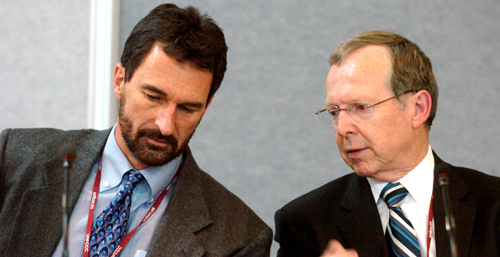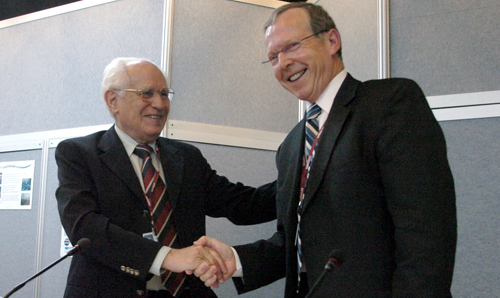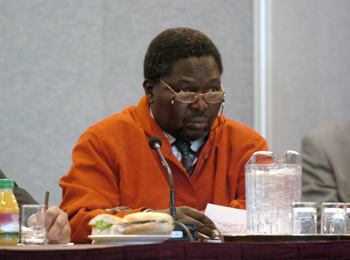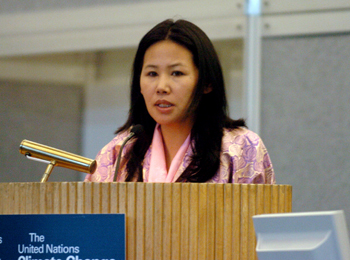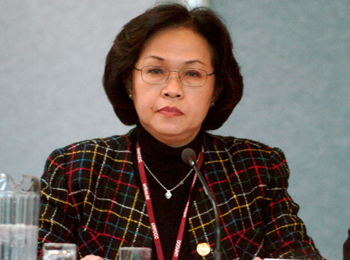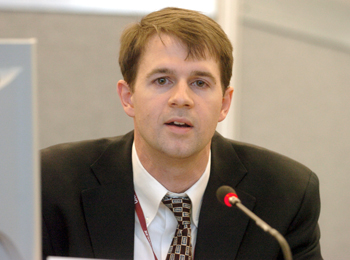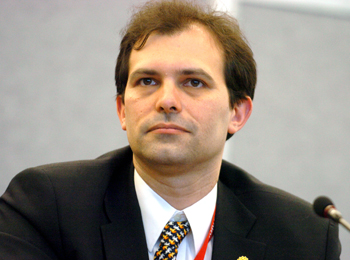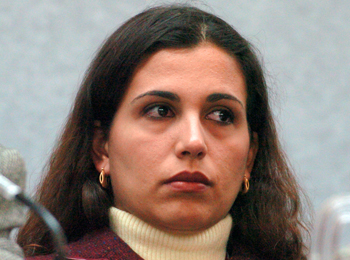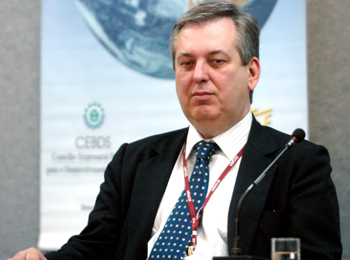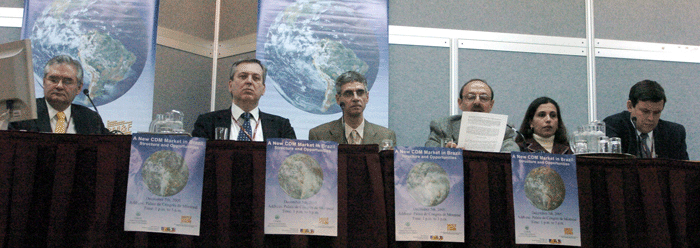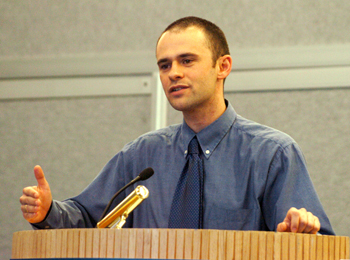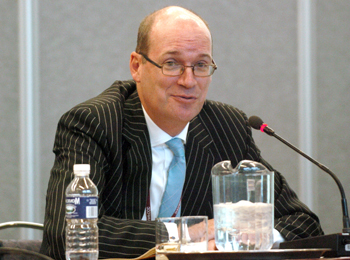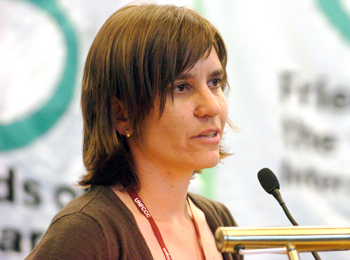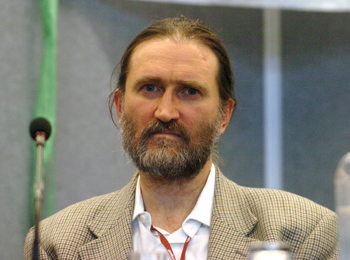 |
||
|
published by IISD, the International Institute for Sustainable Development
in cooperation with the UNFCCC Secretariat. |
|||
|
Special Report on Selected Side Events at COP 11 & Kyoto Protocol COP/MOP 1
|
|||||
| 28 November - 9 December 2005 | Montréal, Canada | |||||
|
No reason to wait Presented by Northeast States for Coordinated Air Use Management |
|||
|
Hal Harvey, Hewlett Foundation, said questions such as whether controlling GHG emissions is too costly in robust economies and affordable for developing nations, need never be asked again. He applauded São Paulo and California for their aggressive energy policy actions, stressing how each demonstrated energy policy can save money and reduce emissions. José Goldemberg, São Paulo State Secretary for the Environment, recognized that Annex 1 and non-Annex 1 countries have common but differentiated responsibilities in addressing climate change, which is not the same as no responsibilities. He highlighted São Paulo’s initiatives to reduce GHG emissions, including: introducing ethanol, created from sugarcane on a large scale; electricity from sugarcane bagasse and landfill gas; and carbon sequestration from land use change, noting that the current price of ethanol has been reduced to be competitive with gasoline. He stressed that São Paulo is proof that solutions exist. Alan Lloyd, California Environment Secretary, stressed the state government’s commitment to solve the issue of conventional pollutants and GHG emissions, and described various California environmental policy initiatives, including vehicle GHG standards and building and appliance standards. He also said per capita energy use in California is significantly below the national average. He said California’s experience provides confidence in addressing the governor’s reduction target goals, including reduction of GHG emissions to 2000 levels by 2010, and said leadership is important in order to address the situation. Gina McCarthy, State of Connecticut Department of Environmental Protection, stressed that Americans are taking action to address climate change at the community, state and regional levels, and said these actions will prove to the federal government that they too must take action. She then highlighted actions taken by the New England Governors and Eastern Canadian Premiers, the State of Connecticut, and the Regional GHG Initiative (RGGI) and said climate change is foremost an energy issue, noting the need to shift investment to energy conservation and efficiency. Peter Lehner, State of New York Office of Attorney General Eliot Spitzer, emphasized that Americans are working hard on addressing climate change, highlighted various lawsuits that focus on GHG emissions reduction, and stressed the need to utilize exiting laws to regulate industry or government polluters in order to address climate change, noting this can be extended to other countries. Heather Kaplan, Nescaum, highlighted the Conference of New England Governors and Eastern Canadian Premiers (NEG/ECP) Climate Action Plan’s goal of reducing emissions to 1990 levels by 2010, and described how the regional plan lays out action items on electricity, transportation, and inventories and registries. She said that eight states and provinces have developed climate action plans and acknowledged the long way to go to achieve targets. Discussion: participants discussed the adoption of best practices by western states, drivers for successful environmental energy policy, viability of corn for ethanol. Discussions after the second panel highlighted price-cap options for RGGI, public education campaigns, and the need for a robust stakeholder process for implementing strong state environmental policies. |
|||
|
|||
|
The Least Developed Country’s Expert Group 2001-2005 Presented by the UNFCCC |
|||
|
Janos Patszor, UNFCCC, introduced the work of the Least Development Country’s Expert Group (LEG) and the National Adaptation Plan of Action (NAPA) process.
Paul Desanker, LEG, Malawi, outlined LEG’s activities and composition as well as some of its products such as annotated guidelines for NAPA preparation, outreach websites, and a database of local coping strategies available on the UNFCCC website. Bubu Pateh Jallow, Ministry of Fishery and Water Resources, the Gambia, discussed the annotated guidelines for NAPA preparation and the NAPA Primer. Dechen Tsering, National Environment Commission Secretariat, Bhutan, focused on NAPA-related technical papers produced by the LEG. Taule’Ale’Ausumai Laavasa Malua, Ministry of Works, Transportation and Infrastructure, Samoa, described regional workshops held for preparation of NAPAs. Madeleine Diouf-Sarr, Ministry of Environment, Senegal, addressed LEG support to francophone countries. Annie Roncerel, UNITAR, highlighted an online NAPA support programme that improves communication and information flow between participants and includes a section on local coping strategies. Mohammed Reazuddin, Department of Environment, Bangladesh, noted the need for NAPA implementation. Discussion: participants focused on funding resources for NAPA implementation, information required for implementation, and challenges in NAPA preparation. |
|||
|
|||
|
ISO 14064: International standards for greenhouse gas quantification, reporting and verification Presented by the International Organization for Standardization |
|||
|
Kevin Boehmer, International Organization for Standardization (ISO), emphasized that the ISO 14064 standards were developed through a transparent and open process.
Jonathan Pershing, World Resources Institute (WRI), explained that the World Business Council for Sustainable Development (WBCSD)/WRI GHG Protocol is the precursor of the ISO standards. Liana Bratasida, Ministry of Environment, Indonesia, noted that the “one country one vote” principle was used in the development of the ISO standards. Brian Dawson, UNDP, mentioned the upcoming launch of the MDG Carbon Facility, which will adopt the ISO standards. Simon Schmitz, WBCSD, indicated that the new ISO standards are compatible with the WBCSD/WRI GHG Protocol. Chan Kook Weng, Malaysian Palm Oil Board, stressed that the ISO standards are backed by technical rigor. Matt Spannagle, UNDP, said the standards on quantification and reporting at the organizational level aim to provide a template for market use to provide clarity and consistency between users and their stakeholders and enhance the credibility, consistency and transparency of GHG quantification, monitoring and reporting. Klaus Radunsky, umweltbundesamt, stressed that the standards should facilitate GHG reduction performance tracking. Christine Schuh, Pricewaterhousecoopers, presented on the validation and verification part of the standards, stressing that it is flexible and not mandatory. Judith Hull, Environment Canada, outlined Canada’s GHG offset system which uses ISO standards and aims at encouraging activities to reduce GHG. |
|||
|
|||
|
WRI Book Launch: Data and Development in Framing Future Climate Commitments Presented by World Resources Institute |
|||||
|
Jonathan Pershing, World Resources Institute (WRI), launched two new books, that encompass visions for the post-2012 climate change process. Kevin Baumert, WRI, said the first book “Navigating the Numbers” presents an analysis of GHG data by country and by sector, and provides conclusions focusing on issues such as global trends, big emitters and emission caps. Rob Bradley, WRI, stated that the second book “Growing in the Greenhouse” examines sustainable development policies and measures (SD-PAM’s) as a means of engaging developing countries in the climate process without compromising development. He provided several SD-PAM examples such as biofuels in Brazil, renewable energy technologies for rural electrification in India, and carbon capture and storage in South Africa. Lee Schipper, WRI, presented a case study on automobile use, fuel use and carbon emissions in China, noting that China is now ready to make choices regarding appropriate urban development and carbon emissions. Discussions: participants noted the need to implement the SD-PAM approach and infrastructural politics in developing countries. |
|||||
|
|||
|
A New CDM Market in Brazil: Structure and Opportunities Presented by Brazil and the Brazilian Business Council for Sustainable Development |
|||||
|
Luiz Figueiredo, Ministry of Foreign Affairs, Brazil, expressed support for stable CDM rules conducive to investment. Newton Paciornik, Ministry of Science and Technology, Brazil, presented Brazil’s national framework and Interministerial Commission on Global Climate Change and noted they have 85 CDM projects in the pipeline. Victor Zveibel, Ministry of Environment, Brazil, described the Ministry’s adaptation and vulnerability studies, emphasizing small scale CDM projects in rural settlements. Marcos Otávio Prates, Ministry of Development, Industry and Foreign Trade, Brazil, noted projects that CDM will enable, including energy capture from pig manure, and reforestation. Samira Sana de Sousa, Ministry of Mines and Energy, Brazil, outlined the benefits of the PROINFA renewable energy project, which has created jobs, introduced new technology, and avoided 2.8 million tons of emissions. Fábio Marques, Plantar, described the accomplishments of Plantar’s CDM plantation project, including providing: a biomass energy source for iron production; achieving Forest Stewardship Council certification; and improving labor conditions. Oswaldo Luccoon, Secretariat of State for the Environment of São Paulo, Brazil, noted the importance of biomass-based ethanol, the potential for replication, and logistical issues that may be overcome through increased demand. Guilherme Fagundes, Bolsa de Mercadorias & Futuros, and Virgílio Gibbon, Fundação Getúlio Vargas, described the development of an online certified emissions reduction trading system to foster CDM opportunities in Latin America, while reducing information and transaction costs. Eduardo Mello, National Development Bank, Brazil, said that the Bank can be a partner in CDM investment, and outlined social and environmental screening criteria used in project selection. |
|||||
|
|||
|
Generating Agricultural Knowledge for Addressing and Responding to Climate Change Presented by the International Water Management Institute |
|||
|
Ian Burton, independent scholar, Canada, noted that the aim of the side-event was to raise awareness about Consultative Group on International Agricultural Research climate change-related research.
Lisa Schipper, International Water Management Institute (IWMI), stressed that poverty reduction and climate change are linked, noting that, since many rural poor rely on agriculture for their livelihoods, water management is critical to any climate change adaptation policy targeting rural poor. She then described IWMI’s Comprehensive Assessment of Water Management in Agriculture. Claudio Forner, Centre for International Forestry Research, noted that most CIFOR climate change research targets mitigation, but that much also applies to adaptation, notably that pertaining to environmental services and livelihoods. He then described a research project examining how tropical forest goods and services should be managed to ensure that development is not undermined by climate change. Robert Zomer, IWMI, said his research reveals the effects of afforestation and reforestation projects on land and water use, noting that on 70 percent of eligible lands such projects will moderately affect water resources and could, potentially undermine food security. Monirul Mirza, University of Toronto, facilitated the discussion in which participants raised issues relating to gender and how poverty reduction must be the ultimate goal of these research projects. |
|||
|
|||
|
The Future of Climate Policy: The Finance Sector Perspective Presented by the United Nations Environment Program Finance Initiative |
|||
|
Sascha Lafeld, 3C, noted that insurance companies, banks and asset managers are developing a sophisticated understanding of how climate change will affect investment decisions, and stressed the need for a secure long-term climate policy regime, a liquid and efficient global carbon market, and clear targets for renewable energy.
Armin Sandhoevel, UNEP Finance Initiative (UNEP FI), outlined the work of the Climate Working Group (CWG). Mark Kenber, Climate Change Group, emphasized that a stable carbon price is the main driver of investment decisions aimed at mitigating exposure to climate risk and that a secure policy regime beyond 2012 is essential. James Cameron, Climate Change Capital and Carbon Disclosure Project, noted how investment firms participating in the Carbon Disclosure Project have a combined asset value of over US$20 trillion and that this figure will rise with a stable carbon price. Helen Sahi, UNEP FI North American Task Force, stated that unless a long-term climate regime is adopted some investors will be negatively exposed to climate risk. |
|||
|
|||
|
Climate Debt: From Concept to Action Presented by Friends of the Earth International |
||||
|
Tony Juniper, Friends of the Earth International (FOEI), stressed adequacy of action, realism and equity in addressing climate change. Roque Pedace, FOE Argentina, presented the concept of “climate debt”, an attempt to establish inter- and intra-generational environmental justice regarding climate change. He noted that there are limitations to the monetary valuation of associated impacts. Carolina Herrmann, FOE Brazil, described the economic and social impacts of the first recorded hurricane in the South Atlantic region of her country, an anomaly linked to elevated sea temperatures. Prakash Sharma, FOE Nepal, said that higher temperatures have led to accelerated glacial runoff and flooding, and has caused hardships for locals. He noted that since part of the Himalayas are designated as a World Heritage Site, signatories to this convention are obliged to act to prevent further loss of glaciers. Stephanie Long, FOE Australia, listed impacts of climate change on small island states of the South Pacific, including: salinization of water tables, increased dependency on imported food, which has elevated diabetes rates; introduction of malaria, associated with temperature rise; and exceptionally high spring tide floods that have washed out cemeteries. Discussion: participants discussed ways to attach a value to climate debt, seek compensation, and make resultant funds available to those suffering the effects of climate change. |
||||
|
|||
|
Adaptation to Climate Change: pathways into the Future beyond 2012 Presented by the Institute for Global Environmental Strategies (IGES) |
||||
| Akio Morishima, IGES, stated that adaptation to climate change is crucial and stressed the need to prepare for the changes that are anticipated to occur over the next several decades.
Ancha Srinivasan, IGES, summarized the findings from field surveys in Bangladesh and of an expert consultation on proactive micro-adaptation. He noted the need for establishing formal mechanisms to local communities’ perspectives in adaptation plans and for creating incentives and financial mechanisms to facilitate adaptation at local level. Ian Noble, World Bank, stated that nearly 40% of the Bank’s projects include climate-sensitive components but only 2% of project design documents explicitly mention climate variability or change and explained Bank’s initiatives in developing tools to assist project developers. Stephen Gitonga, UNDP, described the UNDP-GEF’s adaptation portfolio through providing specific examples of projects in various countries. Mohan Munasinghe, Munasinghe Institute for Development, explained the utility of Action-Impact Matrix in mainstreaming adaptation and mitigation concerns in developmental programmes and policies, and noted that existing mechanisms for adaptation must be fully utilized before looking into new mechanisms. Taka Hiraishi, IGES, stressed the need to integrate adaptation into the development agenda. Monirul Mirza, Adaptation Impacts Research Group of the University of Toronto, said aid agencies can play a constructive role in mainstreaming climate change. Jyoti Parikh, Integrated Research and Action for Development, noted that equity issues are important in addressing adaptation as poor communities in each country are most vulnerable while their contribution to climate change is minimal. Agus Sari, Pelangi, explained that developing an optional protocol for adaptation might enhance focus on the issue but cautioned that broad participation of countries in such protocol cannot be assured. John Mooteb, Department of Economic Affairs of Federated States of Micronesia, noted the urgency of assisting small island developing states in adapting to climate change. |
||||
|
|||
|
||
|
Click the above button to go back to our ENB main coverage
|
||
|
|
|
|
|
||
|



